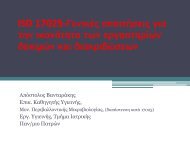Microbiological quality of indoor and outdoor swimming pools in ...
Microbiological quality of indoor and outdoor swimming pools in ...
Microbiological quality of indoor and outdoor swimming pools in ...
You also want an ePaper? Increase the reach of your titles
YUMPU automatically turns print PDFs into web optimized ePapers that Google loves.
390<br />
pathogens <strong>in</strong>volved <strong>in</strong> hospital <strong>in</strong>fections <strong>and</strong> <strong>in</strong>habit<strong>in</strong>g<br />
nosocomial environments. The detailed results <strong>of</strong> the<br />
susceptibility tests are presented <strong>in</strong> Table 4.<br />
The pool with the poorest microbiological <strong>quality</strong> <strong>and</strong><br />
the highest <strong>in</strong>cidence <strong>of</strong> multi-resistant bacterial isolates<br />
was the hydrotherapy pool (Tables 2–5). Out <strong>of</strong> the 132<br />
total water samples collected from the hydrotherapy<br />
pool, 16 (12.1%) yielded THC over 500 cfu/ml <strong>and</strong> eight<br />
(6%) yielded P. aerug<strong>in</strong>osa counts 1500 cfu/100 ml. Also,<br />
28 (73.6%) out <strong>of</strong> the 38 resistant stra<strong>in</strong>s were isolated<br />
ARTICLE IN PRESS<br />
C. Papadopoulou et al. / Int. J. Hyg. Environ.-Health 211 (2008) 385–397<br />
Table 2. Compliance to st<strong>and</strong>ards <strong>of</strong> microbiological parameters for pool water <strong>in</strong> relation to the pool type<br />
<strong>Microbiological</strong> parameter Comply<strong>in</strong>g samples/collected samples (% <strong>of</strong> comply<strong>in</strong>g samples)<br />
Indoor <strong>pools</strong> Outdoor <strong>pools</strong><br />
Childrens’<br />
teach<strong>in</strong>g pool<br />
Hydrotherapy<br />
hospital pool<br />
Competition<br />
public pool<br />
Hotel semipublic<br />
pool<br />
Household<br />
private pool<br />
Total heterotrophic counts at<br />
2072 1C<br />
132/132 (100.0) 90/132 (68.1) 132/132 (100.0) 33/33 (100.0) 33/33 (100.0)<br />
Total heterotrophic counts at<br />
3671 1C<br />
132/132 (100.0) 100/132 (75.7) 132/132 (100.0) 33/33 (100.0) 33/33 (100.0)<br />
Escherichia coli at 3671 1C 132/132 (100.0) 97/132 (73.4) 132/132 (100.0) 33/33 (100.0) 33/33 (100.0)<br />
Total coliforms 132/132 (100.0) 93/132 (70.4) 132/132 (100.0) 33/33 (100.0) 33/33 (100.0)<br />
Fecal coliforms 132/132 (100.0) 89/132 (67.4) 132/132 (100.0) 33/33 (100.0) 33/33 (100.0)<br />
P. aerug<strong>in</strong>osa at 3671 1C 126/132 (95.4) 84/132 (63.6) 132/132 (100.0) 31/33 (93.9) 33/33 (100.0)<br />
L. pneumonophila at 3671 1C 132/132 (100.0) 132/132 (100.0) 132/132 (100.0) 33/33 (100.0) 33/33 (100.0)<br />
S. faecalis 132/132 (100.0) 102/132 (77.2) 132/132 (100.0) 33/33 (100.0) 33/33 (100.0)<br />
S. aureus 127/132 (96.2) 95/132 (71.9) 129/132 (97.7) 33/33 (100.0) 33/33 (100.0)<br />
Mycobacterium spp. 132/132 (100.0) 132/132 (100.0) 132/132 (100.0) 33/33 (100.0) 33/33 (100.0)<br />
Pathogenic fungi 132/132 (100.0) 110/132 (83.3) 132/132 (100.0) 33/33 (100.0) 33/33 (100.0)<br />
Table 3. Range <strong>and</strong> mean values <strong>of</strong> microbial counts from pool water samples<br />
<strong>Microbiological</strong> parameters Range values (mean values)<br />
Indoor <strong>pools</strong> Outdoor <strong>pools</strong><br />
Children<br />
teach<strong>in</strong>g pool<br />
Hydrotherapy<br />
pool<br />
Competition<br />
public pool<br />
Hotel semipublic<br />
pool<br />
Household<br />
private pool<br />
Total heterotrophic counts at<br />
2072 1C (cfu/ml)<br />
0–10 (0.2) 0–394 (20.4) 0–5 (0.5) 0–4 (0.02) 0–3 (0.01)<br />
Total heterotrophic counts at<br />
3671 1C (cfu/ml)<br />
0–12 (0.5) 0–504 (26.8) 0–4 (0.2) 0–2 (0.06) 0–2 (0.01)<br />
Escherichia coli at 3671 1C (cfu/<br />
100 ml)<br />
0 0–55 (4.2) 0 0 0<br />
Total coliforms (cfu/100 ml) 0 0–75 (3.0) 0 0 0<br />
Fecal coliforms (cfu/100 ml) 0 0–46 (5.1) 0 0 0<br />
Pseudomonas spp. (cfu/100 ml) 0–17 (0.2) 0–1500 (19.8) 0 0–80 (0.01) 0<br />
Streptococcus faecalis (cfu/100 ml) 0 0–24 (2.4) 0 0 0<br />
Staphylococcus spp. (cfu/100 ml) 0–80 (0.4) 0–100 (4.9) 0–4 (0.4) 0 0<br />
C. albicans (cfu/500 ml) 0 0–40 (3.5) 0 0 0<br />
Pathogenic fungi (cfu/500 ml) 0 0–10 (1.6) 0 0 0<br />
from the hydrotherapy pool water. Accord<strong>in</strong>g to the<br />
Cl<strong>in</strong>ical Microbiology <strong>and</strong> the Urology Department<br />
records, uro-genital <strong>and</strong> ear <strong>in</strong>fections (otitis externa)<br />
were more common <strong>in</strong> bathers us<strong>in</strong>g the hydrotherapy<br />
pool, than the bathers us<strong>in</strong>g other <strong>pools</strong>. However,<br />
dur<strong>in</strong>g the period <strong>of</strong> this study no evident differences or<br />
<strong>in</strong>creased prevalence <strong>of</strong> related <strong>in</strong>fections was reported<br />
between the bathers <strong>and</strong> non-bathers, or amongst the<br />
various bath<strong>in</strong>g groups, particularly the hydrotherapy,<br />
children’s teach<strong>in</strong>g <strong>and</strong> competition pool users.



